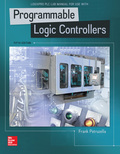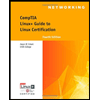
EBK LOGIXPRO PLC LAB MANUAL FOR PROGRAM
5th Edition
ISBN: 8220102803503
Author: Petruzella
Publisher: YUZU
expand_more
expand_more
format_list_bulleted
Expert Solution & Answer
Chapter 2, Problem 31RQ
Explanation of Solution
Resolution of an analog input channel:
- • The resolution of an input signal is defined as the least most change in the input signal value sensed by the module...
Expert Solution & Answer
Want to see the full answer?
Check out a sample textbook solution
Students have asked these similar questions
"Do not use AI tools. Solve the problem by hand on paper only and upload a photo of your handwritten solution."
"Do not use AI tools. Solve the problem by hand on paper only and upload a photo of your handwritten solution."
"Do not use AI tools. Solve the problem by hand on paper only and upload a photo of your handwritten solution."
Chapter 2 Solutions
EBK LOGIXPRO PLC LAB MANUAL FOR PROGRAM
Ch. 2 - Prob. 1RQCh. 2 - What is the function of a PLC output interface...Ch. 2 - Prob. 3RQCh. 2 - Prob. 4RQCh. 2 - Prob. 5RQCh. 2 - Prob. 6RQCh. 2 - Prob. 7RQCh. 2 - Prob. 8RQCh. 2 - Prob. 9RQCh. 2 - Prob. 10RQ
Ch. 2 - Prob. 11RQCh. 2 - What are the advantage and the disadvantage of...Ch. 2 - With reference to PLC discrete input modules: a....Ch. 2 - Prob. 14RQCh. 2 - Explain the function of the backplane of a PLC...Ch. 2 - Prob. 16RQCh. 2 - Prob. 17RQCh. 2 - Prob. 18RQCh. 2 - What electronic element can be used as the...Ch. 2 - With reference to discrete output module current...Ch. 2 - What electronic element can be used as the...Ch. 2 - Prob. 22RQCh. 2 - Prob. 23RQCh. 2 - Prob. 24RQCh. 2 - Prob. 25RQCh. 2 - Prob. 26RQCh. 2 - Prob. 27RQCh. 2 - Prob. 28RQCh. 2 - Prob. 29RQCh. 2 - Explain the difference between a unipolar and...Ch. 2 - Prob. 31RQCh. 2 - In what two ways can the loop power for current...Ch. 2 - Prob. 33RQCh. 2 - Prob. 34RQCh. 2 - Prob. 35RQCh. 2 - Write a short explanation for each of the...Ch. 2 - Write a short explanation for each of the...Ch. 2 - Prob. 38RQCh. 2 - Prob. 39RQCh. 2 - Prob. 40RQCh. 2 - Prob. 41RQCh. 2 - Prob. 42RQCh. 2 - Prob. 43RQCh. 2 - Prob. 44RQCh. 2 - Prob. 45RQCh. 2 - Prob. 46RQCh. 2 - Prob. 47RQCh. 2 - What information is normally stored in the ROM...Ch. 2 - Prob. 49RQCh. 2 - Prob. 50RQCh. 2 - Prob. 51RQCh. 2 - Prob. 52RQCh. 2 - Prob. 53RQCh. 2 - Prob. 54RQCh. 2 - Prob. 55RQCh. 2 - Prob. 56RQCh. 2 - Prob. 57RQCh. 2 - Prob. 58RQCh. 2 - Prob. 59RQCh. 2 - Prob. 60RQCh. 2 - What is the function of a transducer?Ch. 2 - Prob. 62RQCh. 2 - Prob. 1PCh. 2 - Assume a thermocouple, which supplies the input to...Ch. 2 - With reference to I/O module specifications: a. If...Ch. 2 - Prob. 4PCh. 2 - Prob. 5PCh. 2 - Prob. 6P
Knowledge Booster
Similar questions
- "Do not use AI tools. Solve the problem by hand on paper only and upload a photo of your handwritten solution."arrow_forwardSolve this "Do not use AI tools. Solve the problem by hand on paper only and upload a photo of your handwritten solution."arrow_forward"Do not use AI tools. Solve the problem by hand on paper only and upload a photo of your handwritten solution."arrow_forward
- "Do not use AI tools. Solve the problem by hand on paper only and upload a photo of your handwritten solution."arrow_forwardSpecifications: Part-1Part-1: DescriptionIn this part of the lab you will build a single operation ALU. This ALU will implement a bitwise left rotation. Forthis lab assignment you are not allowed to use Digital's Arithmetic components.IF YOU ARE FOUND USING THEM, YOU WILL RECEIVE A ZERO FOR LAB2!The ALU you will be implementing consists of two 4-bit inputs (named inA and inB) and one 4-bit output (named out). Your ALU must rotate the bits in inA by the amount given by inB (i.e. 0-15).Part-1: User InterfaceYou are provided an interface file lab2_part1.dig; start Part-1 from this file.NOTE: You are not permitted to edit the content inside the dotted lines rectangle. Part-1: ExampleIn the figure above, the input values that we have selected to test are inA = {inA_3, inA_2, inA_1, inA_0} = {0, 1, 0,0} and inB = {inB_3, inB_2, inB_1, inB_0} = {0, 0, 1, 0}. Therefore, we must rotate the bus 0100 bitwise left by00102, or 2 in base 10, to get {0, 0, 0, 1}. Please note that a rotation left is…arrow_forwardSolve this "Do not use AI tools. Solve the problem by hand on paper only and upload a photo of your handwritten solution."arrow_forward
- Solve this "Do not use AI tools. Solve the problem by hand on paper only and upload a photo of your handwritten solution."arrow_forward"Do not use AI tools. Solve the problem by hand on paper only and upload a photo of your handwritten solution."arrow_forwardSolve this "Do not use AI tools. Solve the problem by hand on paper only and upload a photo of your handwritten solution."arrow_forward
- Solve this "Do not use AI tools. Solve the problem by hand on paper only and upload a photo of your handwritten solution."arrow_forwardSpecifications: Part-2Part-2: DescriptionIn this part of the lab, we will illuminate two 7-segment displays. You will need to understand 2's Complement todetermine when the input 4-bit binary number corresponds to a negative or positive number. To understand how anLED display works in Digital, please refer to the playWithLED_Display.dig file provided. You should play withdifferent input combinations to see how it influences the LED Display value. In the screenshot below, note how I wasable to generate the display of “3” on the Hex display by lighting up only certain input wires to the unit. Here is a picture of how the different segments light up to produce the different displays: Note in the picture above that we showed displays only from 0-8 since in 4-bit 2s complement representation, 8 is thelargest modulus value you can represent (the range of integers would be -8 to +7).Your circuit in Part-2 must accept a 4-bit 2's complement input {in3, in2, in1, in0} where in3 is the most…arrow_forwardSolve this "Do not use AI tools. Solve the problem by hand on paper only and upload a photo of your handwritten solution."arrow_forward
arrow_back_ios
SEE MORE QUESTIONS
arrow_forward_ios
Recommended textbooks for you
 Systems ArchitectureComputer ScienceISBN:9781305080195Author:Stephen D. BurdPublisher:Cengage Learning
Systems ArchitectureComputer ScienceISBN:9781305080195Author:Stephen D. BurdPublisher:Cengage Learning CompTIA Linux+ Guide to Linux Certification (Mind...Computer ScienceISBN:9781305107168Author:Jason EckertPublisher:Cengage Learning
CompTIA Linux+ Guide to Linux Certification (Mind...Computer ScienceISBN:9781305107168Author:Jason EckertPublisher:Cengage Learning Principles of Information Systems (MindTap Course...Computer ScienceISBN:9781285867168Author:Ralph Stair, George ReynoldsPublisher:Cengage Learning
Principles of Information Systems (MindTap Course...Computer ScienceISBN:9781285867168Author:Ralph Stair, George ReynoldsPublisher:Cengage Learning Enhanced Discovering Computers 2017 (Shelly Cashm...Computer ScienceISBN:9781305657458Author:Misty E. Vermaat, Susan L. Sebok, Steven M. Freund, Mark Frydenberg, Jennifer T. CampbellPublisher:Cengage Learning
Enhanced Discovering Computers 2017 (Shelly Cashm...Computer ScienceISBN:9781305657458Author:Misty E. Vermaat, Susan L. Sebok, Steven M. Freund, Mark Frydenberg, Jennifer T. CampbellPublisher:Cengage Learning Fundamentals of Information SystemsComputer ScienceISBN:9781305082168Author:Ralph Stair, George ReynoldsPublisher:Cengage Learning
Fundamentals of Information SystemsComputer ScienceISBN:9781305082168Author:Ralph Stair, George ReynoldsPublisher:Cengage Learning

Systems Architecture
Computer Science
ISBN:9781305080195
Author:Stephen D. Burd
Publisher:Cengage Learning

CompTIA Linux+ Guide to Linux Certification (Mind...
Computer Science
ISBN:9781305107168
Author:Jason Eckert
Publisher:Cengage Learning


Principles of Information Systems (MindTap Course...
Computer Science
ISBN:9781285867168
Author:Ralph Stair, George Reynolds
Publisher:Cengage Learning

Enhanced Discovering Computers 2017 (Shelly Cashm...
Computer Science
ISBN:9781305657458
Author:Misty E. Vermaat, Susan L. Sebok, Steven M. Freund, Mark Frydenberg, Jennifer T. Campbell
Publisher:Cengage Learning

Fundamentals of Information Systems
Computer Science
ISBN:9781305082168
Author:Ralph Stair, George Reynolds
Publisher:Cengage Learning